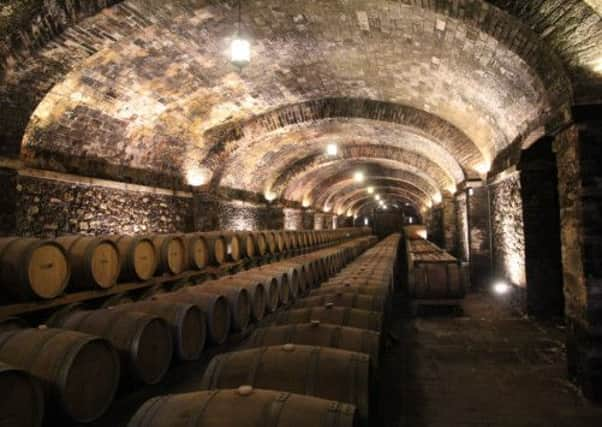Drink in the atmosphere


Many families load up the 4x4 at the start of the school holidays and after a couple of days’ driving across France and into Italy, can be found soaking up the sunshine at some remote villa in the hills around Florence.
Visiting wine estates is a popular pastime when the attractions of the swimming pool fade but there is a new way of getting to grips with Tuscany’s wines as a number of wine estates throw open their houses and go into the luxury tourism business.
Advertisement
Hide AdAdvertisement
Hide AdThe aim behind this new initiative is not just to fill up spare bedrooms with tourists but to demonstrate the link between this unique historic region and its wonderful wines, and while most of these estates are less suitable for a summer-long family-style holiday, they are the perfect getaway for weekends and short holidays.
Capannelle Estate, around 40km south of Florence just outside the tiny village of Gaiole in Chianti is a great example. This is the personal estate of James B Sherwood who owns the Cipriani in Venice and Villa San Michele in Florence, but rather than feeling overwhelmed by luxury, this actually feels like a great quality B&B that happens to be on a wine estate. The style is informal, the rooms are well-designed and comfortable, but best of all, the cellar leads down from the dining room and the wine is excellent.
“We like our guests to know that they are sleeping close to the barrels,” said winemaker Simone Monchetti who lives on the estate and who is available to take guests around the cellars and vineyards at the drop of a hat. The house itself is a restored 16th-century farmhouse and the old cellars have been turned into one of the most delightful, small-scale, top-quality wineries I have seen in a long time. Chianti Classico Riserva is the main wine with bright fruit and savoury notes with an 80 per cent Sangiovese-based Solare adding more depth and character to the range. An interesting diversion is 50:50, made in collaboration with Montepulciano producer Avignonesi which is labelled as a humble regional wine but which packs fabulous plum and herbal notes to justify its 95 euro price tag.
With just five rooms, and just one long dining table to encourage conversation between guests this is a friendly, small-scale place to stay. Rooms cost between 200 and 300 euros per night. Check www.capannelle.com for details.
Advertisement
Hide AdAdvertisement
Hide AdOn a totally different scale, Il Borro is for people who want to escape from reality and stay in a medieval village which has been brought up to date with style and panache. The style is to be expected since the investment behind this project comes from the Ferragamo family, more noted for their fabulous fashions, and the houses and apartments are classic, well-designed and functional.
This is a private village, complete with winding streets, an ancient church and small shops selling artisan goods rather than tourist souvenirs. You want a pair of handmade shoes? The little shoe shop can oblige.
The experience of staying at Il Borro might be a little like that experienced by generations of Tuscan farmers, but with comfortable beds, 21st century plumbing and two restaurants on-site. If you have a large family group you can take over the manor house with 10 bedrooms, two swimming pools and a staff of three for a mere 8,000 euros per night.
The wines of Il Borro come from the surrounding vineyards and the cellars are open for tours and tasting everyday. (www.ilborro.com)
Advertisement
Hide AdAdvertisement
Hide AdAnother branch of the Ferragamo family, Massimo, has developed Castiglione del Bosco in the Montalcino DOC both as a wine estate and as a luxury resort, transforming the estate village into villas and apartments. This is a place to stay to get away from it all and enjoy great food and wine. (www.castiglionedelbosco.com)
The property that revived the fortunes of Montalcino 40 years ago, and which still produces more of this wine than anyone else in the region, Castello Banfi is also in the tourism business. When the day visitors to this stunning castle have tasted their way through the range and climbed back on their buses, the street of houses and apartments overlooking the vineyards becomes peaceful once more. An on-site restaurant provides a locally-sourced menu and there are cookery courses available if you want to cook as well as eat. (www.castellobanfi.it)
As an example of how wine tourism is changing in Italy, the Dievole (www.dievole.it) estate is a key example. I arrived for a visit and while the estate is stunningly beautiful, spread across the hillsides and surrounded by vineyards, the atmosphere was less polished than Il Borro or other already-developed estates. But the food was fabulous, the swimming pools already in place and the wines extremely good. The new owner, an Argentinian former oil-man, is planning to invest some of his billions and revitalise this estate’s accommodation and vineyards. Plans have already been drawn up, although Alejandro Bulgheroni was reluctant to give details apart from mentioning that top wine consultant Alberto Antonini was joining the team.
It will take a while for this slightly jaded estate to reach the standard of the others but I rather liked its authenticity and enthusiasm right now. Its prices are less eye-watering than some of the grander, more exclusive estates and so Dievole might just provide a taster-experience for wine tourism novices.